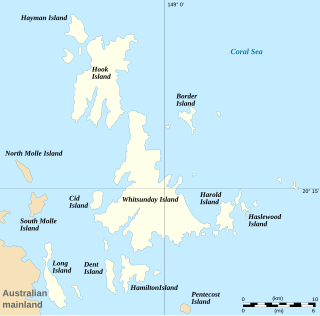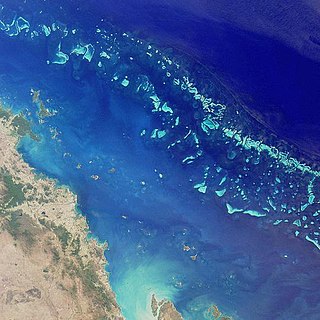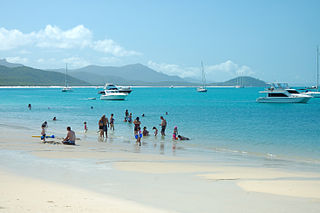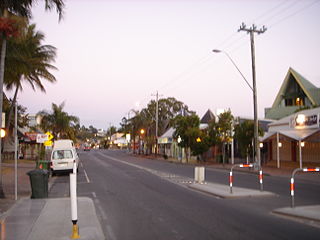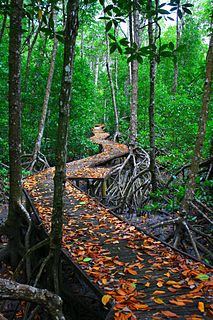
The Great Barrier Reef Marine Park protects a large part of Australia's Great Barrier Reef from damaging activities. It is a vast multiple-use Marine Park which supports a wide range of uses, including commercial marine tourism, fishing, ports and shipping, recreation, scientific research and Indigenous traditional use. Fishing and the removal of artefacts or wildlife is strictly regulated, and commercial shipping traffic must stick to certain specific defined shipping routes that avoid the most sensitive areas of the park. The Great Barrier Reef is the largest and best known coral reef ecosystem in the world. Its reefs, almost 3000 in total, represent about 10 per cent of all the coral reef areas in the world. It supports an amazing variety of biodiversity, providing a home to thousands of coral and other invertebrate species, bony fish, sharks, rays, marine mammals, marine turtles, sea snakes, as well as algae and other marine plants.

Brampton Islands is a national park in the Mackay Region, Queensland, Australia, 834 kilometres (518 mi) northwest of Brisbane. The park covers much of Brampton Island and all of Carlisle Island.

Green Island National Park is a protected area declared over a small coral cay of Green Island, Cairns Region, Queensland, Australia. It is known to the local Gungganyji Aboriginal peoples as Dabuukji. The Gungganyji people used the island as an initiation ground.

Lizard Island is an island on the Great Barrier Reef in Queensland (Australia), 1624 km northwest of Brisbane and part of the Lizard Island Group that also includes Palfrey Island. It is part of the Lizard Island National Park. Lizard Island is within Cook Shire.

South Cumberland Islands is a national park in Queensland, Australia, 831 km northwest of Brisbane. It is famous for the Marine stingers which can be found in the waters of the park between October and May.

Hinchinbrook Island lies east of Cardwell and north of Lucinda, separated from the northern coast of Queensland, Australia by the narrow Hinchinbrook Channel. Hinchinbrook Island is part of the Great Barrier Reef Marine Park and wholly protected within the Hinchinbrook Island National Park, except for a small and abandoned resort. It is the largest island on the Great Barrier Reef. It is also the largest island national park in Australia.

Great Keppel Island lies 15 kilometres (9.3 mi) from the coast off Yeppoon in the Shire of Livingstone, Queensland, Australia. It is part of the Capricorn Coast of Central Queensland. The island is the largest of the eighteen islands in the Keppel Group, and covers an area of 1308 hectares. It is within the local government area of Shire of Livingstone.
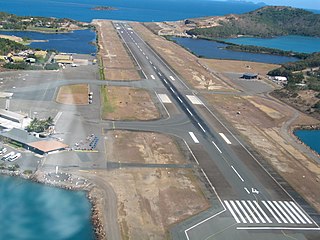
Great Barrier Reef Airport or Hamilton Island Airport is a privately owned public use aerodrome and is the primary airport of the Whitsunday Islands Group, and the airport of Hamilton Island. The airport is settled on mostly reclaimed land and due the island's tourism status, is occupied mostly and favoured by Australia's leading low-cost airline Jetstar Airways, as well as Virgin Australia and Qantas. Hamilton Island Airport handles direct flights from Sydney, Melbourne, Brisbane and Cairns and is also the airport launch pad for scenic flights to the Great Barrier Reef and Whitehaven Beach. Private flights and charters also fly into Great Barrier Reef Airport, along with locally operated helicopters, light planes and seaplanes.

Air Whitsunday is a charter airline based in Australia that operates a fleet of seaplanes. The company also operates tours.

The geography of Queensland in the north-east of Australia, is varied. It includes tropical islands, sandy beaches, flat river plains that flood after monsoon rains, tracts of rough, elevated terrain, dry deserts, rich agricultural belts and densely populated urban areas.
The Ngaro were a seafaring Australian Aborigine group of people that inhabited the Whitsunday Islands and coastal regions of Queensland, in an area that archaeologically shows evidence of human habitation since 9000 BP. Ngaro society was destroyed by warfare with traders, colonists, and the Australian Native Police. The Native Police Corps forcibly relocated the remaining Ngaro aborigines in 1870 to a penal colony on Palm Island or to the lumber mills of Brampton Island as forced laborers.
Great Palm Island, also known as Palm Island, or by the Aboriginal name Bwgcolman; is a tropical island with a resident community of about 2,000 people. The island has an area of 55 km2 (21 sq mi). The official area figure of 70.9 km² refers to Aboriginal Shire of Palm Island and includes nine smaller islands. It is in Queensland, Australia, off the east coast of northern Queensland, situated 65 kilometres (40 mi) northwest of Townsville, and 800 kilometres (500 mi) north of the Tropic of Capricorn. The Australia Post lists the local post office as Palm Island, QLD. It is the main island of the Greater Palm group, and consists of small bays, sandy beaches and steep forested mountains rising to a peak of 548 metres (1,798 ft). The ocean surrounding the island is part of the Great Barrier Reef Marine Park where extraction and fishing are regulated.

Hamilton Island is the largest inhabited island of the Whitsunday Islands in Queensland, Australia. It is positioned approximately 887 kilometres (551 mi) north of Brisbane and 512 kilometres (318 mi) south of Cairns. It is also the only island in the Great Barrier Reef with its own commercial airport, with short direct flights from Sydney, Melbourne, Brisbane and Cairns. Like most in the Whitsunday group, Hamilton Island was formed as sea levels rose which created numerous drowned mountains that are situated close to the east coast of Queensland. At the 2011 Australian Census, the island recorded a population of 1,208 people. Hamilton Island is a popular tourist destination all year round. In late August, the island plays host to its annual Hamilton Island Race Week yachting festival, in which more than 250 yachts from across Australia and New Zealand gather for a week of races around the Whitsunday Islands. This is only one of many events hosted on the island. Hamilton Island has won multiple awards including the Australian Traveller 'Most Desirable Island Escape' Award in 2015.
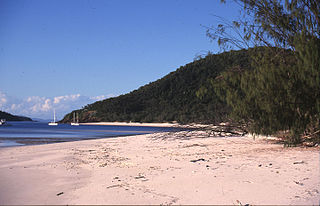
Chalkie's Beach is located on the western coast of Haslewood Island in the Whitsunday Islands of Queensland, Australia. It lies across from the more popular Whitehaven Beach on the main Whitsunday Island.






